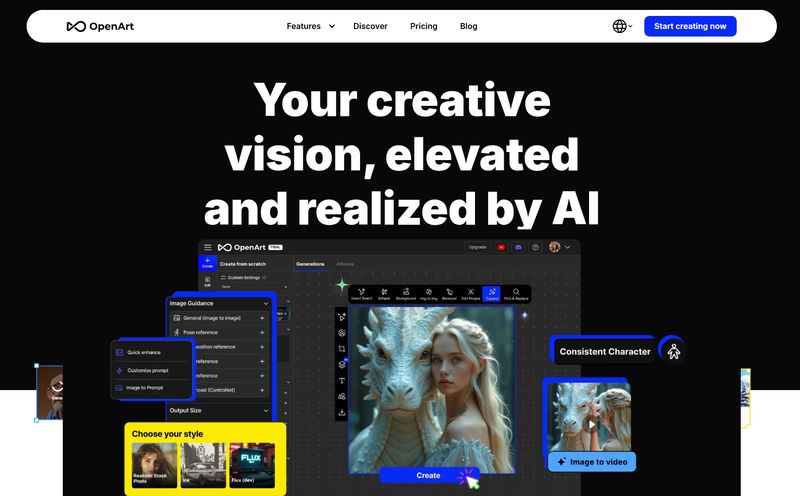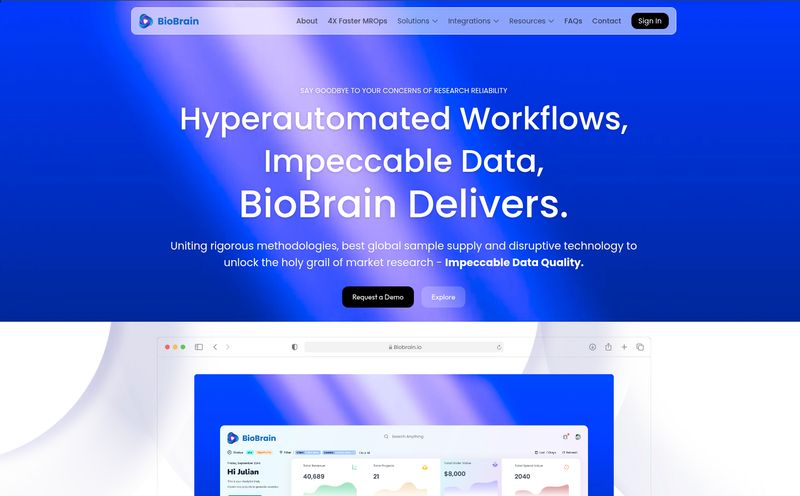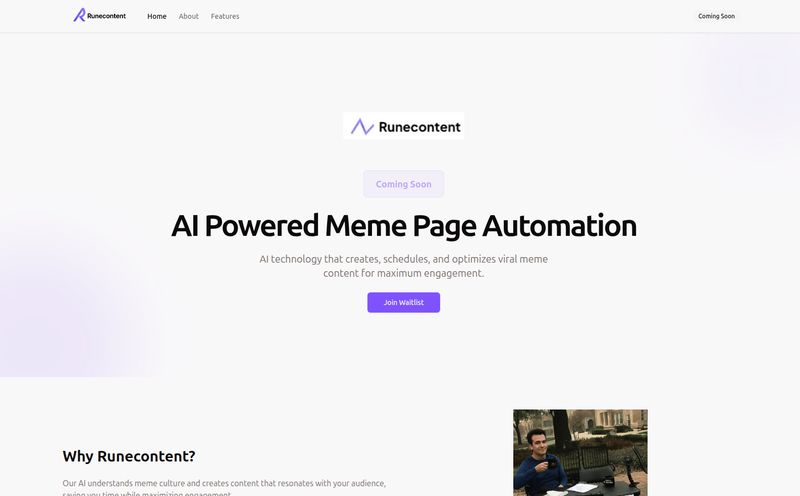Alright, let’s have a real chat. If you’re anything like me, you’ve spent more hours than you’d care to admit staring at a blinking cursor in a ChatGPT or Claude window. You type a prompt. You get a response. You tweak the prompt. You get another response. You scroll up, scroll down, trying to remember what you asked three variations ago. It’s a linear, often frustrating process. A digital conversation, sure, but not exactly a brainstorm.
I’ve always felt like my brain works more like a whiteboard than a text document. Ideas connect, branch off, and form clusters. The standard chat interface for large language models (LLMs) just doesn’t reflect that chaotic, beautiful process. It's like trying to paint a landscape through a keyhole.
Then I stumbled upon a tool called Dreamspace. The name itself is intriguing, right? It promises an “infinite canvas for exploring the outputs of large language models.” An infinite canvas? For my prompts? My curiosity was definitely piqued.
So, What Exactly Is This Dreamspace Thing?
Imagine a giant, digital corkboard. Or a mind-mapping app like Miro, but built specifically for talking to AI. That’s the closest analogy I can come up with for Dreamspace. Instead of a single, endlessly scrolling chat log, you get a sprawling, visual workspace.
You start with a prompt in a little box (or a “node,” as they call it). The AI's response appears next to it. But here’s where the magic starts. You can drag that response to another part of the canvas, branch off from it with a new prompt, or create a totally separate prompt nearby to compare ideas. It’s built for what the creators call “rapid prompt development,” and I can see why. It’s less of a conversation and more of a collaborative ideation session with your AI assistant.

Visit Dreamspace
It’s aimed squarely at folks who are serious about using LLMs – we’re talking artists generating concepts, engineers testing API calls, and researchers exploring the weird and wonderful corners of a model’s “mind.”
The Standout Features That Got My Attention
I'm a sucker for a good feature set, but only if it actually solves a problem. Dreamspace seems to have a few tricks up its sleeve that address some of my biggest pet peeves with standard AI interfaces.
The Infinite Canvas - Your Creative Sandbox
This is the main event. The ability to visually organize your thoughts is a game-changer. You can have one cluster of nodes for brainstorming blog post titles, another for drafting email copy, and a third for generating Python code, all on the same screen. Seeing the connections—or lack thereof—between different lines of inquiry is something you just don’t get from a text file. It turns the process of prompt engineering from a chore into a form of creative exploration. It's like gardening for ideas; you plant a seed (a prompt) and see what grows, pruning and grafting as you go.
Prompt Chaining and Forking is an Adventure
Okay, this is where it gets really cool for the power users. Prompt chaining means you can take the output from one node and directly use it as the input for a new one. For example, you could ask the AI to “Generate five marketing slogans for a new coffee brand.” Then, you can drag your favorite slogan, connect it to a new node, and prompt it with, “Now, write a 200-word social media post based on this slogan.” It creates a visual, logical flow that’s incredibly powerful.
Forking is just as neat. It's like creating parallel universes for your prompts. Let's say you have a prompt you like, but you want to see how it performs with slight variations. You can “fork” it, creating several copies, and tweak each one differently. “Write a poem about the sea in the style of Edgar Allan Poe.” Fork it. “Now do it in the style of Emily Dickinson.” Fork it again. “Now, just make it funny.” You can see all three outputs side-by-side. It’s brilliant for A/B testing your creative ideas.
Rapid Experimentation and Comparison
The visual layout naturally lends itself to comparison. You can generate a hundred variations of an image prompt for Midjourney or craft dozens of product descriptions and just… look at them. You can visually group the good ones, trash the bad ones, and see patterns emerge. It’s so much faster than copy-pasting things into a spreadsheet, which, I’ll admit, I have done on more than one occasion.
My Honest Take – The Good, The Bad, and The Messy
No tool is perfect, and it’s my job to be a bit of a skeptic. Dreamspace is exciting, but it’s not without its considerations.
The Good Stuff
The biggest pro is the sheer speed and intuitive nature of brainstorming. It just feels more natural to me. The visual flow helps me think better and make connections I might have missed. For anyone who considers themselves a “visual thinker,” this tool will likely feel like coming home. The ability to quickly chain and fork prompts without losing your place is, frankly, something I wish was standard in every LLM interface.
A Few Caveats
First, the very thing that makes it great—the infinite canvas—could also be its downfall. I can easily see myself creating a sprawling, chaotic mess of nodes that becomes overwhelming. You’ll need a bit of self-discipline to keep your workspace organized. Think of it as a real desk: it's only useful if you dont let it get buried in papers.
Second, this tool is probably most effective if you already have some grasp of prompt engineering. It doesn’t hold your hand. It gives you a powerful sandbox, but the quality of the castles you build depends on your skill. A newcomer might not know what to do with all that freedom.
And finally, it's important to state the obvious: Dreamspace is a user interface. Its effectiveness is completely tied to the quality of the large language model running underneath. If the underlying AI gives you garbage outputs, Dreamspace will just help you organize that garbage more prettily.
Who Should Be Using Dreamspace?
So, is this for everyone? Probably not. If you just use AI to ask for recipes or summarize the occasional article, this might be overkill.
However, if you fall into one of these camps, I think you should give it a serious look:
- Prompt Engineers & Developers: This is your playground. Building and refining complex prompt chains is what this tool was made for.
- Writers & Content Creators: Brainstorming articles, outlining chapters, generating social media campaigns… the visual organization is a massive boost to the creative process.
- AI Artists: Perfect for developing and iterating on complex text-to-image prompts. You can document your entire creative journey from a simple idea to a finished masterpiece.
- Researchers & Academics: Ideal for exploring model behavior, testing hypotheses, and documenting experimental findings in a structured, visual way.
What's the Deal with Pricing?
Here’s the million-dollar question. As of my writing this, pricing information for Dreamspace isn't readily available on their site. This is pretty common for new tools in the tech space that might be in beta or still figuring out their business model. My advice? Head over to their official website and see what the current status is. They might have a free trial, a beta program, or pricing tiers by the time you read this.
Frequently Asked Questions about Dreamspace
- 1. In simple terms, what is Dreamspace?
- Think of it as a mind-map or a digital whiteboard for your AI. Instead of a simple chat, you get a visual space to create, connect, and compare lots of different AI prompts and their answers all at once.
- 2. How is this different from just using ChatGPT?
- The main difference is the interface. ChatGPT is a linear, back-and-forth conversation. Dreamspace is a non-linear, visual canvas where you can explore many ideas in parallel, see how they relate, and build complex chains of thought.
- 3. Do I need to be a programmer to use it?
- Not at all! However, a basic understanding of how to write effective prompts (prompt engineering) will help you get the most out of it. It’s built for users who want to go beyond simple questions and answers.
- 4. Can I connect my own AI models or API keys?
- The information suggests the tool's effectiveness depends on the "underlying LLMs," which implies there might be options to use different models, but you'd have to check their official documentation for specifics on connecting APIs like OpenAI's or Anthropic's.
- 5. Is Dreamspace a free tool?
- Currently, the pricing details are unclear. It's best to check the official Dreamspace website for the most up-to-date information on any costs, trials, or free versions.
Final Thoughts: A Step in the Right Direction
I’m genuinely excited about tools like Dreamspace. For too long, we’ve been forced to interact with incredibly complex AI through the simplest, most restrictive interfaces. It’s like having a supercomputer that you can only talk to through a walkie-talkie.
Dreamspace represents a move toward a more intuitive, human-centric way of collaborating with artificial intelligence. It acknowledges that creativity is messy, non-linear, and visual. While it may have a slight learning curve and the potential for beautiful chaos, it’s a powerful concept that I believe points to the future of how we’ll all work with LLMs. It’s a tool that doesn’t just give you answers; it gives you a space to think.
Reference and Sources
- Official Website: dreamspace.ai
- Microsoft Learn: Introduction to prompt engineering



